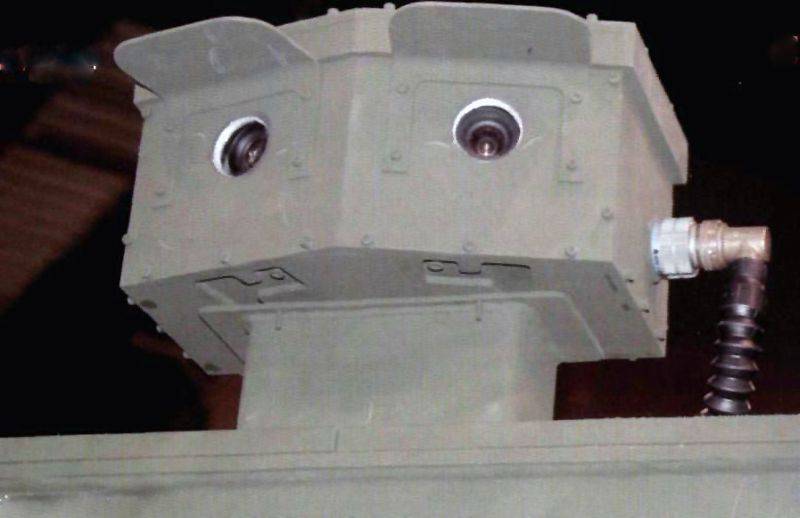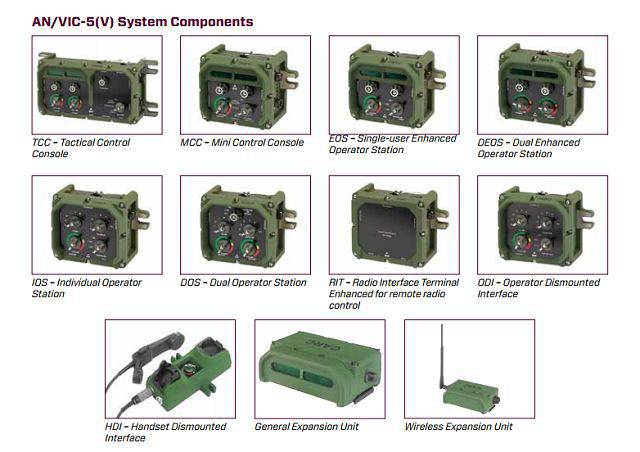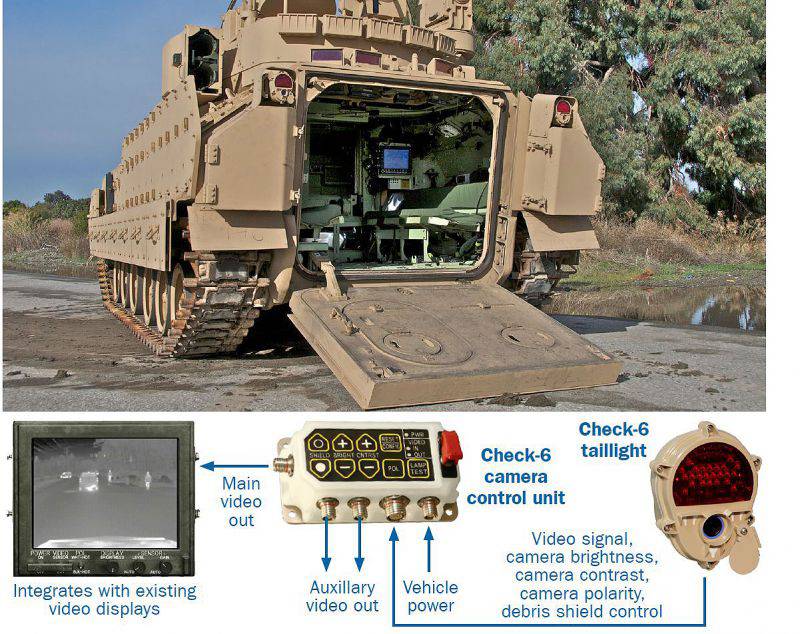Four-dimensional war

Non-blinking eyes, such as this anthropomorphic system developed by General Dynamics, are becoming an important component of BBM future plans.
Gaps in the situational awareness of the crew of the car ... its perception of the threats and events around it is very important for survival. His concerns are varied, whether it is an armored unit that has fallen out of sight at the moment, but is operating at some distance on the flank, be it a group of grenade launchers hiding in the nearest alley, waiting for the BMP to show them its vulnerable stern, finally, whether it's natural a threat, such as a steep ramp that can become an insurmountable obstacle to a large and heavy MRAP machine.
Systems for presenting images and information that allow the crew of an armored combat vehicle (BBM) to be notified of these and other threats become mandatory for new projects, in addition, such systems have become a major component of modernization and improvement programs since their appearance on the market. A significant impetus to the development and acquisition of situational awareness systems was the operation in Iraq, which was characterized by significant threats to its forces and the need to attract BBM to conduct combat operations in urban areas.
Battle management systems
Combat control systems (SMS) in command vehicles have been used for many years to access a large picture. Currently, an increasing number of countries have chosen to expand their ability to access information up to individual machines in order to guarantee each member of the unit the benefits that situational awareness provides. There are no two identical SMSs, but, nevertheless, they share several common features, mainly differing in other areas, for example, in the ease of use of the graphical user interface. Common properties include automatic display of friendly (allied) forces, as well as the ability to enter locations and other information about enemy units. This key information and, of course, any other information is then distributed among the units in a particular network and further up the command chain. The advantages here are significant both from an offensive point of view regarding the reduction of information transfer time in the “sensor-shooter” chain, and from the point of view of reducing the loss of one's forces from friendly fire.
The Tsayad DAP (Digital Army Program - Digital Army Program) of the Israeli army, which uses the Elbit Systems TORC2H system, called MASSUAH, each version of which is interchangeable, but corresponds to the specific tasks and priorities of the unit, is one of the most integrated SMS. The most advanced version is equipped with a unit standing on the Golan Heights, which is a reflection of the high confidence of the Israeli army in this system. The next version of DAP is currently being developed. Elbit Systems should also supply TORC2H-based systems for the Land 75 / 125 Australian Army program with machines equipped with an enhanced Enhanced Tactical Computer Mk4 tactical computer. The contract was issued in 2010 year and is estimated at approximately 300 million dollars. These systems can work with higher-level systems, such as the Saab Battle Command Support System, which has already been deployed, the FBCB2 system (brigade-level and below ACS), as well as other army systems, such as the Advanced Advanced Field Artillery Transmission System Raytheon's Field Artillery Tactical Data System for indirect fire control.
Systematic recently launched its new software for SITAWARE FRONTLINE BMS, which was tested by the Danish army and its special forces. The basic principle of the system is the use of portable user data in such a way that commanders can connect to the system from any machine and work efficiently on any screen, starting with eight inches. Up the command chain, the system is also fully compatible with other elements of the Systematic automated control systems family.
The Cobham Defense Communications SUB is a BATTLE HAWK family of systems designed to operate at all levels, from the lowest to the highest. It began with a variant adapted for a dismounted soldier, inside the so-called Integrated Digital Soldier System (IDSS). It can seamlessly interact with the BATTLE HAWK Vehicle System (BHVS) vehicle system and the BATTLE HAWK Command System (BHCS) command system. The latter is designed to work on large screens at headquarters at various levels.
The French SCORPION will include the current and future armored vehicles of the French army with a network system built around the new battalion-level and combat-level operational units known as the combined-arms tactical group Groupement Tactique Interarmes (GTIA). In terms of the SMS, it will replace several existing SMS, namely the Nexter SITV1 and Sagem SITEL and in the future the EADS SIR regiment level system. It will be replaced by a single system known under the designation SICS (Systeme d'lnformation du Combat Scorpion - information combat system Scorpion) after completing the three main stages of SCORPION. The higher-level systems used by the French will remain mainly on the basis of the French operational information system Systeme d'lnformation Operationelle and the army information system Systeme d'lnformation des Armees. The team, consisting of Thales, Nexter and Sagem, working on the MARS project (Maitrise de Architecture SCORPION - SCORPION architecture development), was awarded the contract for the creation of the SCORPION architecture in November 2011.
Vehicle architecture and intercom
While the power of the SMS is a function of the external network and its ability to transmit information about the battlefield to each machine in real or close to real time, the use of sensors installed in the machine is a function of the internal network. The software installed in it must ensure that each crew member can see everything that happens in the immediate vicinity of the vehicle and react to it. Vehicle architectures are a further development of vehicle intercommunication, extending network capabilities on board to meet new requirements. In the UK, vehicle architectures are being developed through the so-called Land Open Systems Architecture (LOSA), which aims to provide an open service-oriented mechanism known as the Generic Vehicle Architecture (GVA) - Defense Standard (Def-Stan) 23 -09 (common [standard] architecture for vehicles) and aimed at the development of on-board electronics architecture. The first example of these capabilities, deployed in the military, is the new FOXHOUND mine-protected machines purchased by the UK. The US approach in this area is known as VICTORY (Vehicle Integration) for the C4ISR / EW standard.
The new German PUMA BMP is equipped with the same Thales SOTAS IP intercom system as in the BOXER BMP, which allows you to connect to a more global network of operational management consisting of Combat Force C2 Systems FUWESIFIS and FulnfoSys H Bundeswehr systems. The system is also capable of receiving data from the machine itself, for example the amount of ammunition through the CAN-Open interface. This is an interface on the CAN bus that uses the TL-0030 compatibility protocol, connecting the respective systems via an Ethernet TCP / IP channel.
Thales is also tasked with integrating its VSys-net Open Information Communication System (OICS) into the vehicle architecture for 257 Malaysian new 8x8 wheeled vehicles, assembled by DEFTECH. Thales supplies the SMS and platform management system itself.
In its work on the GD UK SCOUT Specialist Vehicle, which is being developed for the UK, Thales uses the Core Infrastructure Distribution System (CIDS), which is a compact communication system with 20 Gb / s Ethernet Pipe bandwidth, which interconnects numerous nodes in the machine with access to the onboard servers for storing and retrieving data during the execution of a combat mission.
Other commercial solutions include Northrop Grumman’s SMART Integrated Vehicle Area Network (SiVAN) with wired nodes and an encrypted wireless channel built into the system. DRS Tactical Systems created the C4lnSight system, while ST Electronics showed its ST6800 SuperneTridgeular Integrated Communication System, which was installed on the TERREX 8x8 BMP of the Singapore Army.
Telephonies Modular Vehicle Communications Management Systems, better known as NetCom-V / TruLink, provides the ability for crew members to communicate over an Ethernet LAN and network switch, allowing simultaneous transmission of voice data and location data.
Greek company Intracom has installed its system of broadband intercom and secure packet radio in Greek Tanks LEOPARD 2. This system was part of the SMS and network delivered by General Dynamics to the former Libyan regime before the NATO operation. Naturally, the new government must now pick up a new system.
BAE Systems' CHECK-6 sensor is a pioneer in the market
Observation, sensors and situational awareness in vehicles
A number of additional, partially overlapping functionally sensors are installed on the external surfaces of the machine, the images from which are collected and displayed on crew members' monitors in order to timely detect a potential threat and quickly respond to attacking actions. For large cars, they also serve as a significant help when maneuvering in narrow streets and help to avoid the exit from the road or bridge.
These sensors are different from sensors that are used in reconnaissance and observation tasks, since they are short-range (only a few hundred meters) and much cheaper. Of course, only a combination of day sights and thermal imagers is able to detect most of the threats in total darkness fog, smoke and most of the tools that make it difficult to observe.
The Norwegian company Kongsberg used its remote-controlled combat modules of the PROTECTOR series as a base for the situational awareness system of vehicles. The ONE 360 system (Observe Navigate Engage - to observe, direct, capture) is currently in service. The shooter works with the combat module and the ONE 360 system, which allows you to instantly get a full-length image in azimuth 360 ° and in elevation in the sector plus or minus 35 ° with a frame rate of less than 100 milliseconds and digital zoom. In order to cope with the impact of weapons, the situational awareness system is fully stabilized and has automatic tilt compensation.
The solution with the talking name See Through Armor (developed through armor) developed by Elbit Systems uses sensors that are connected via a Gigabit Ethernet channel. The system supports up to 12 daytime sensors and 12 thermal imaging cameras with an uncooled FLIR bolometric matrix of either 384x288 or 640x480. Throughput allows you to transfer video from a daytime camera at a frequency of 25-100 frames per second and video from a night camera at a frequency of 25 frames per second. The company Elbit declare that the latency of the system is such that crew members see images with a delay of no more than two frames. The system algorithms allow you to create a panoramic image of the video streams of different cameras. The concept also allows the integration of other airborne systems, in particular, the SMS, which can, based on information obtained from the system’s sensors, provide control signals to the warning and armament systems.
The system from Rheinmetall SA System provides panoramic (360 °) situational awareness with a high-resolution camera (one megapixel) with a field of view of 180 ° in azimuth and ± 30 ° in elevation. In addition to the main solution, the company offers several optional modules for inclusion in the system. Tracking & Tracing via Rheinmetall Multi Mode Tracker (MMT) - multi-mode tracking device; The Rheinmetall Acoustic Sniper Locating System (ASLS) is a sniper positioning system and the Rheinmetall Laser Warning Receiver (LWR) is a laser warning system receiver. For demonstration purposes, these systems were installed on a wide variety of vehicles, including the LEOPARD II tank.
Imagine another system for the main battle tank - the CHECK-6 from BAE Systems, which is part of the Tank Urban Survivability Kit (a set of additional equipment and reservations for the Abrams tank, which increases its combat capabilities in urban settings) of the American army.
One of the first decisions on the market was the system Integrated Local Situational Awareness (ILSA) from the company Thales. The ILSA system is based on a signal distribution unit with 32 video inputs that supports multiple displays. The incoming video signals come from different sensors, including the compact thermal imaging camera included in the ILSA system with the 640x480 matrix, the 138 ° viewing sector and the 30 ° horizontal field of view; it provides recognition of the machine at a distance of 340 meters and a person at a distance of 140 meters. The ILSA system along with the Integrated Integrated Digital Mission System (IDMS) integrated functional system was selected for the British FOXHOUND machines.
In order to meet the military's need for situational awareness, Selex Galileo created its ROAD MARSHAL system. Selex decided not to develop a new sensor, but to use the existing night vision system for the driver based on an uncooled bolometric matrix operating in the 8-12 micron range. The UK has chosen this system to install MASTIFF on their machines.
All of the above systems are fixed surveillance systems that have a full range of coverage by installing several different sensors. Other systems (and more efficient ones) are, as a rule, systems on a universal joint, used for long-range observation. These include Star SAFIRE LV and TALON LD (Land) from FLIR Systems, as well as installed on MX-10GS vehicles from L-3 Wescam and Mini-POP from IAI for solving such problems.
FLIR Systems has in its portfolio the system THERMOVISION SA, representing the implementation of a situational awareness solution for vehicles. It is based on non-cooled Visible high-resolution thermal imaging cameras under various designations SA18, SA40, SA63 and SA90, where the number corresponds to the field of view in degrees. SA40 and SA63 models can be installed in a single unit for a wider coverage. The top model in the THERMOVISION line is SA180 with 180 ° x45 ° viewing angles, which is described as the first panoramic thermal imager on the market with an 180 ° field of view. FLIR sees it as a component that is integrated into more accurate systems and complements their capabilities. A SA180 thermal imager using digital zoom can detect a person at a distance of 500 meters.

The AN / VIC-5 / TacGa vehicle intercom system from Cobham / Northrop Grumman. The US Army has chosen it as its next generation internal communications system, as well as a possible basis for a situational awareness system. These companies also supply their previous generation ROVIS / ANVIC-3 system to foreign countries.
Hack and predictor Aviator
Situational awareness for modern BBM is achieved through a multi-level holistic approach. To it are primarily staff the possibility of the machine itself to provide visual and audible signals to the crew in response to threats detected by means of a short-range observation. These opportunities would ideally be used in conjunction with sensors and sighting-range installed on the machine as part of its normal combat system, for example, the guidance system of the machine gun combat. Information generated by modern multifunctional information and control systems with irregular information from various sources and presented to the crew on the SMS screen can be added to this sensor, which serves as the basis for a situational awareness system. Whether they are real-time warning signals that require an immediate response to a threat, be it information that allows you to plan your actions (used, for example, to choose a route to bypass superior enemy forces or to set up an ambush), situational awareness systems are vital for machines to survive and crews.
Materials used:
www.elbitsystems.com
www.cobham.com
www.intracomdefense.com
www.rheinmetall-defence.com
www.baesystems.com

Information